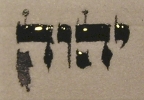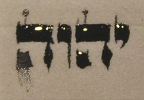
Here's a case where a small child came in handy, though. The final hey in a Divine Name got smudged accidentally, so it sort of looks like an ugly hey and it sort of looks like an ugly kuf. It's definitely one or the other, but which?
Remember you aren't allowed to erase Divine Names or any part thereof. You really, really, really aren't allowed to do it.
If the letter is a hey, the Divine Name is still, as it were, live. The smudgy part would have to stay there, not be erased to make it tidier. If the letter is a hey, we must leave it alone.
If the letter is a kuf, the Divine Name will have been switched off, and we can remove the smudgy part and make it back into a pretty hey. It can't stay as a kuf. If the letter is a kuf, we must erase it.
We need a decision. Which is it? Adult brains see the problem in shades of grey, and become unable to reduce it to the necessary black and white. Young child brains only see things in black and white, so we use their eyes. My friend Hillel's young child told us that the letter was a kuf, so kuf it was.
***Really technical bit coming up***
You have to erase a smudge like this from the top down, not the bottom up. Very important. If you erase from the bottom up, you'll at some point turn the letter back into hey, but by hak tokhot. A letter made by hak tokhot isn't a proper letter from the perspective of Torah reading, but it's definitely a proper letter from the perspective of erasing Divine Names. So if, during your erasing, you make this:

you've got a REAL problem – a hey that isn't valid, but which you can't erase and write validly.
This is one of the reasons soferim have to study lots of halakha; so that they know how to anticipate and avoid pickles like that.




No comments:
Post a Comment